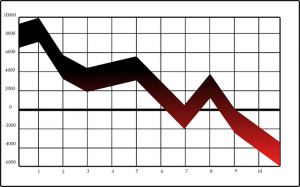You should think about how a tool like the stochastic oscillator can assist you with identifying what’s available in the marketplace and how you can benefit from it.
how a tool like the stochastic oscillator can assist you with identifying what’s available in the marketplace and how you can benefit from it.
The stochastic oscillator is designed to give you a forecast of how the value of a stock will change dependent on the trading that’s occurring. The complete value might imply that the value could go in a specific direction which is more beneficial to you.
The title”stochastic oscillator” might seem strange to even the most seasoned dealers. What makes this instrument so fascinating? The stochastic oscillator focuses on the stochastic process for quantifying stock performance. It believes many probabilities. The random procedure produces a collection of variables to understand the way the stock moves. The main purpose is to work out the closing price of a stock within the variety of prices that it’s seen. Specifically, it functions within a 14-day period since it is a timeframe.
You may use the stochastic oscillator to determine if the moving average is sensible. Although the moving average by itself could be an interesting measurement, it’s not always going to remain moving in precisely the exact same direction.
The stochastic oscillator works using a sensible formulation:
The market rate for a stock = 100 x (recent closing price — lowest cost in the previous fourteen days) / (highest cost in the previous fourteen days — lowest cost in that same time period) The market rate of the stock is a measurement of whether a stock has been overbought or oversold. More people are selling that stock than anticipated and moving well outside of what the typical low might be.
Here’s an example of how this could work:
1.
- Its greatest total in the past fourteen days was $114.
- The lowest total in the exact same time period was $108.
- We’ll subtract the lowest total of $108 in the current closing price of $109. This leads to a total of 1.
5.
- $1 is divided by $6 to equivalent 0.1666.
- This is the overall stochastic oscillator number.
The 16.666 amount for PepsiCo indicates that a lot of people are selling the inventory. What’s more, people are overselling the inventory. This gives the impression that PepsiCo’s stock value will keep falling in value. At exactly the exact same time, this could show that PepsiCo stock is cheap and people are valuing it less than what it’s actually worth.
PepsiCo indicates that a lot of people are selling the inventory. What’s more, people are overselling the inventory. This gives the impression that PepsiCo’s stock value will keep falling in value. At exactly the exact same time, this could show that PepsiCo stock is cheap and people are valuing it less than what it’s actually worth.
The vital portion of the stochastic oscillator is to observe how the value calculated indicates a stock is moving up or down. The market rate calculated here concentrates on how confident people may be about a stock versus how they may not be supportive.
People might begin to sell their shares when a stock’s stochastic oscillator market value goes over 80. This is due to the belief that the stock isn’t likely to be purchased by a number of other individuals soon. When the number is high, the stock seems to be costly. It shows that it may be hard for people to buy a stock and more people than expected are purchasing it. What’s more, such a high overall implies that the stock will reach its peak sooner or later.
Do not forget that an overbought stock will have fewer new individuals possibly buying that stock in the future. This means that the stock may still drop in value. The value might become stable at this time as well due to a lack of real activity. At this time, it seems that people are uncomfortable with the stock and are selling it at a high pace. Additionally, it suggests that the stock is cheap and might potentially be on the upswing again.
overbought stock will have fewer new individuals possibly buying that stock in the future. This means that the stock may still drop in value. The value might become stable at this time as well due to a lack of real activity. At this time, it seems that people are uncomfortable with the stock and are selling it at a high pace. Additionally, it suggests that the stock is cheap and might potentially be on the upswing again.
Going back to the PepsiCo instance, the very low market value of 16.666 reveals that the stock is falling in value and nobody wants to invest in it. This is also a sign that the inventory may be on its way back up as the amount of people that are selling the inventory might soon decline.
The big guideline for  strategizing trades with the stochastic oscillator is to see where the inventory goes when it gets under 20 or over 80 in market value. You might discover that the stock will decrease in value after it seems to be overbought or upward when it’s oversold. It’s around these times when investors will see that the inventory is changing in value and may be prepared to make a turn in value. You’ll need to be cautious when pinpointing how the inventory might change based on what the oscillator says.
strategizing trades with the stochastic oscillator is to see where the inventory goes when it gets under 20 or over 80 in market value. You might discover that the stock will decrease in value after it seems to be overbought or upward when it’s oversold. It’s around these times when investors will see that the inventory is changing in value and may be prepared to make a turn in value. You’ll need to be cautious when pinpointing how the inventory might change based on what the oscillator says.
Can You Change the Time?
Most people using the stochastic oscillator utilize 14-day averages. This is a fantastic standby for shorter transactions as it provides a great idea of how a stock is moving. You also have the choice to use a shorter time period if you desire. You could take a look at the trades in the previous seven days or even the previous six hours. By narrowing the time frame which the stochastic oscillator uses, you’re effectively taking a closer look at how a stock is performing at a shorter period of time.
stochastic oscillator utilize 14-day averages. This is a fantastic standby for shorter transactions as it provides a great idea of how a stock is moving. You also have the choice to use a shorter time period if you desire. You could take a look at the trades in the previous seven days or even the previous six hours. By narrowing the time frame which the stochastic oscillator uses, you’re effectively taking a closer look at how a stock is performing at a shorter period of time.
Strategies For Trading With the Oscillator
Review the Lines
The first plan is to examine the lines created by the oscillator. It is possible to use a computer program to create an oscillator line depending on the data reviewed over a collection of trading periods. Look at the way the line goes in between peaks and valleys. See that the line is relatively smooth and it will not have any important jags. This gives the impression that changes from low to high are controlled and consistent.
lines created by the oscillator. It is possible to use a computer program to create an oscillator line depending on the data reviewed over a collection of trading periods. Look at the way the line goes in between peaks and valleys. See that the line is relatively smooth and it will not have any important jags. This gives the impression that changes from low to high are controlled and consistent.
This works much better when you’ve got a larger sampling to work with. You might see that the changes occur with varying intensities. Sometimes they may change dramatically. Much more importantly, you must watch for any sideways movements within the lines. Any sideways moves that challenge the pure smooth flow of the inventory may suggest that a stock has continuous intervals where enormous buyoffs or selloffs have taken place.
Review Idle Periods
There are often times when the stochastic oscillator will remain around the same price. The oscillator could stay below 20 or above 80 for a couple of days at a time. An idle period on the oscillator implies that the inventory will continue to move along a specific trend for some time.
After the oscillator keeps on moving, it implies that the stock will keep moving in precisely the exact same way it was going. Unlike cases where the oscillator keeps moving up and down, it’s a little easier to determine where something will proceed based on the way the idle periods to get a stock might seem.
As an example, you might see that the stock is falling in value while the oscillator isn’t shifting much beyond the 20 range. This proves that the stock is most likely going to continue to be offered by individuals and that the inventory will continue going down in value. The inventory could always get above 20 after a while, but it may take a little because of the struggles that have such a stock at this juncture.
Have you ever taken a look at the way the stochastic oscillator works on a trading platform? The chances are you might see another line moving alongside it. This is the trend line which reveals how the stock is moving in value. Look at the way the stochastic oscillator line goes together with the trend line on a stock.
the way the stochastic oscillator works on a trading platform? The chances are you might see another line moving alongside it. This is the trend line which reveals how the stock is moving in value. Look at the way the stochastic oscillator line goes together with the trend line on a stock.
Watch the way the trend lines are organized depending on the complete value of the stochastic oscillator. The likelihood of the stock price going down if the two lines meet at 80 or greater are far better than when both lines are separated from one another. This is also the case when both lines are under 20.
Watch the Thresholds
In other words, it would take some time for the oscillator to go from being out the 20 to 80 mark. You must watch for when the stock eventually breaks through one of those thresholds. By investing when a stock moves to the 20 to 80 range, you’ll get a better opportunity to have the inventory move into a specific position.
In actuality, it’s even better if you set your threshold within that interval. This could enable you to put a trade or an option as soon as it is possible to affirm that the stock is moving in one direction. As an example, you may use a stochastic number of 45 or 50. In other words, you’d see for when the stock moves over 20 and see how well the stock goes together with the oscillator.
Needless to say, you won’t make much gain at this juncture since the purchase price is a bit higher or lower than what you may have anticipated. Creating a trade at this time is an excellent idea when you consider the way the stock may be moving at this juncture. What’s more, you will prevent purchasing a stock which may stall. Although there’s a possibility that a stock could escape from the extremes on the oscillator, there’s also a chance that the stock will flat-line and not move much.
Watch for when the stochastic oscillator amount is consistent rather than changing. This is often a sign that people in the marketplace aren’t fully confident in that inventory. They may feel that a stock isn’t likely to shift in worth much or they are uncertain about whether a stock is rewarding. You have the right to enter a posture at this time, but you should at least look at the general history of the inventory and some recent trends that took place to see what may come together as the value changes.
oscillator amount is consistent rather than changing. This is often a sign that people in the marketplace aren’t fully confident in that inventory. They may feel that a stock isn’t likely to shift in worth much or they are uncertain about whether a stock is rewarding. You have the right to enter a posture at this time, but you should at least look at the general history of the inventory and some recent trends that took place to see what may come together as the value changes.
Specifically, a stock is going to have a market rate of 0 if the lowest value in a period of time is also the most recent close. This implies that the inventory is always moving down and may not be likely to change. You can see if the stock has a prospect of climbing, but even then, it may take some time for a stock to move from a hole as striking or hard as this.
To sum up, the stochastic oscillator should be used to give you an idea of what might come about when you’re searching for an excellent investment. The oscillator can help you determine how the value of a stock might go up or down based on whether it’s being overbought or oversold. Compare it with other aspects in the stock to find out if it’s the suitable step to use for your investment.